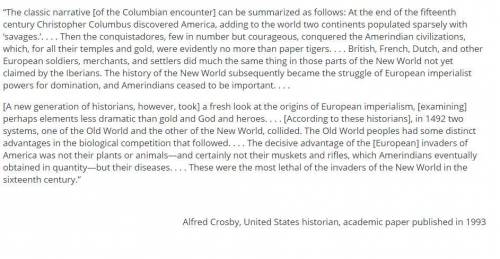 4
4 The correct answer to this open question is the following.
Unfortunately, you did not include the two maps. Without them, we do not know your specific reference.
However, trying to help you and after doing some deep research, we can say the maps portray the Spanish, British, and Dutch trade maritime routes from 1750 to 1850. The other map shows the many trade routes in 2010 that practically crossed all over the world.
That is why we can answer that one significant reason for changes in the patterns of global economic interactions from circa 1750 to circa 2000, as illustrated by the two maps are the technology and modernization of means of transportation that today include land, air, and sea.
Trade has been the activity that has developed most rapidly all over the world in those years. Today, there are international organizations and free trade agreements that connect the world through trade.
More people on the planet started to require more products from all places and developed nations exploited natural resources and raw materials and produced more and better goods in their industrialized cities that were exported.
 2
2 see explanation and i got an a btw.
Explanation:
b. The development of diseases in the sixteenth century would support the arguments of the “new generation of historians in the second paragraph because the “new generation of historians” would look at this in relation to european imperialism and see the impact of the european diseases like smallpox that would plague places like modern day united states because of the european immunity, but lack of native immunity.
c. The “biological competition” contributed to the European imperialism in the Americas by creating a survival of the fittest environment where the europeans brought in diseases like smallpox that had plagued europe generations ago, but infected the native populations and weaken them in both their numbers and their strength, which enabled the Europeans to take control of the new world and develop a dominance while the natives were fighting a disease. This was “biological competition” because the Europeans' immunity was assisting them in fighting the natives' lack thereof.

 13
13 A) Ethnic divisions hindered the development of land-based empires in the period 1450-1750. For example, the Manchu people in the Qing Dynasty in China sought to preserve their ethnic values while ruling China, which proved to be an obstacle for them to rule the vast majority of Han Chinese.
B) Ethnic divisions also hindered the development of maritime empires in the period 1450-1750. For example, the ethnic division between the French colonists and the Haitian people led to multiple Haitian rebellions and ultimately the Haitian Revolution against France.
C) Many land-based empires and maritime empires institutionalized hierarchical distinctions amongst different ethnic groups, often with the use of slavery. The European colonists, for instance, made African Americans the lowest class in American society by enslaving them. Similarly, Christians under Ottoman rule are recruited as janissaries. In both examples, the ruling class adopted policies that limit the social mobility of the ethnic groups that are alien to themselves.
 17
17 In general, because of his numerous achievements, Akbar was awarded the epithet "the Great." The majority of Akbar's achievements military-related.
Explanation:
One aspect in which Akbar's efforts in financing the translations stated in the text are comparable to rulers of other empires throughout the era 1450-1750 is that they both intended to improve their people's well-being by creating educational opportunities and religious books translations. During this time, Akbar and other monarchs aspired to translate sacred books in order to spread education, religion, and history. As well as to bring together Jewish, Hindu, and Muslim faiths in order to avoid future confrontations.For more information, refer to the link:
link
 181
181 By reading the above text, we can have a lot of information about the city of Quanzhou and Chinese trade. Based on this, we can answer the questions as follows:
1. One historical process that explains the religion of Srivijaya merchants in Quanzhou is the growth of maritime trade in that region. This trade promoted the passage of many different people, with different religions that influenced the local population. Among these religions, Mahayana Buddhism was one of the greatest influences.2. One aspect of China's economic development during the Song Dynasty was the establishment of international trade relations. During the Song Dynasty, China became involved in the global market and became a strong influence on international trade which attracted many buyers to its products and strengthened the economy.3. The purpose of the author of the text was to draw the attention of foreigners to show that Quanzhou had great commercial power and that commercial relations with that city were promising. For this reason, he shows plenty of praise for the city, as well as displaying its economic advantages.More information:
link
 4
4 1. Mahoney states that "the needs of speakers drive language change" (nsf.gov).
5. Johnson claims that the English language began to deviate from its Germanic origins (4).
6. In the eighteenth century, English was "departing from its original Teutonick character"(Johnson 4).

 61
61 The disintegration of the Abbasid Caliphate led to B. The rise of Turkic states
The Abbasid Caliphate was vital for the consolidation of Islamic rule and the cultivation of cultural and intellectual development in the Middle East.
The disintegration of the Abbasid Caliphate led to the rise of Turkic states. After the downfall of Abbasid Caliphate, Ottomans established Turkic states.
In conclusion, the correct option is B.
Read related link on:
link
[youtube=0B3qN_FG-1U] 6
6 Capitalism, Marketing, and Production/Consumption
Explanation: Capitalism means an economic and political system in which a country's trade and industry are controlled by private owners for profit, rather than by the state. Marketing means the action or business of promoting and selling products or services, including market research and advertising. And Production/Consumption means the action of making or manufacturing from components or raw materials, or the process of being so manufactured. Hope this helps :)

It will provide an instant answer!
